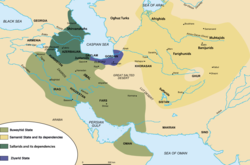Mardavij
| Mardavij مرداویج | |
|---|---|
Gilan | |
| Died | January 935 Isfahan |
| Father | Ziyar |
| Mother | Sister of Harusindan |
| Religion | Zoroastrianism |
Mardavij (Gilaki/Persian: مرداویج, meaning "man assailant") was an Iranian prince, who established the Ziyarid dynasty, ruling from 930 to 935.
Born to a
He then defeated the Daylamite military leader Makan ibn Kaki, and conquered Tabaristan in 932. By 934, his authority was acknowledged as far as Shiraz[2] and Ahvaz.[3] However, his goal of recreating the Iranian Empire was ruined when he was murdered by his own Turkish slaves in 935.
Background

Mardavij was born ca. 890 in
Rise to power
Around 913, Mardavij joined the army of
Reign

In the same year, Makan managed to defeat Mardavij, and briefly recover Tabaristan. Makan then extended his rule over most of Gurgan and even took possession of
Mardavij then aggressively began expanding his domains, by attacking Asfar, who was now residing in Hamadan after his disastrous defeat. In 931, Mardavij managed to defeat and kill Asfar. He then began quickly capturing the
Just after Mardavij's victory,
Death
In January 935, shortly before
Legacy
Mardavij was one of the most notable figures in northern Iran known for preserving and advocating pre-Islamic Iranian customs.[10] During the Pahlavi era, where interest in pre-Islamic Iran was high, Mardavij appeared as the hero in stories and comic strips of children's magazines in the 1960s.[10]
References
- ISBN 9781316184301.
Later on, Mardavij made threats against Baghdad and the caliphate, declaring his intention to restore the Iranian monarchy and the Zoroastrian religion.
- ^ a b c d e Madelung 1975, p. 213.
- ^ Bosworth 2010.
- ^ a b c d e Madelung 1975, p. 212.
- ^ a b Madelung 1969, p. 88.
- ^ a b c d Nazim 1987, p. 164.
- ^ Madelung 1975, p. 211.
- ^ Busse 1975, p. 273.
- ^ a b Busse 1975, p. 254.
- ^ a b Bromberger 2011.
Sources
- ISBN 0-521-20093-8.
- Bosworth, C. E. (2010). "ZIYARIDS". Encyclopaedia Iranica, Online Edition.
- Nazim, M. (1987). "Mākān b. Kākī". In Houtsma, Martijn Theodoor (ed.). E.J. Brill's first encyclopaedia of Islam, 1913–1936, Volume V: L–Moriscos. Leiden: BRILL. pp. 164–165. ISBN 90-04-08265-4.
- Busse, Heribert (1975). "Iran under the Būyids". In ISBN 0-521-20093-8.
- Madelung, W. "GĪLĀN iv. History in the Early Islamic Period". Encyclopaedia Iranica, Online Edition. Retrieved 27 February 2016.
- Madelung, W. (1969). The Assumption of the Title Shāhānshāh by the Būyids and "The Reign of the Daylam (Dawlat Al-Daylam)". Vol. 28. Journal of Near Eastern Studies, vol. 28, no. 2. pp. 84–108. )
- Bromberger, Christian (2011). "GILĀN xv. Popular and Literary Perceptions of Identity". Encyclopaedia Iranica.
External links
- ISBN 0710090994.
